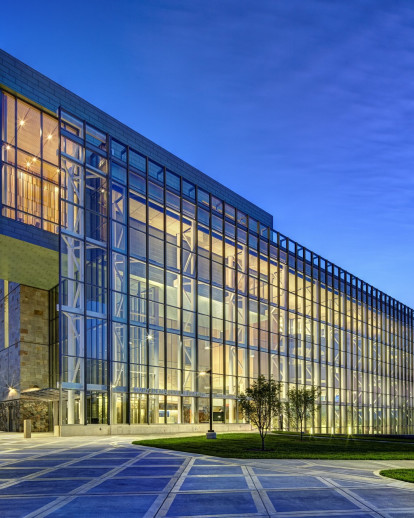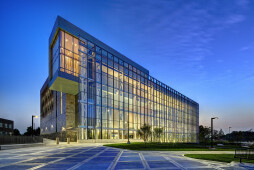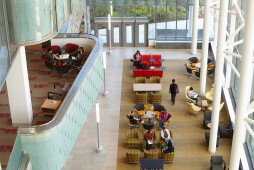Grand Valley State University’s (GVSU) Mary Idema Pew Library, Learning and Information Commons represents a true shift in library design. Inspired by the changing needs of today’s students and the evolving skill sets required in the workplace, the new 150,300 SF library, which opened in June 2013, is designed not only to meet its users’ current needs, but also to bridge the gap between the classroom and the workplace.
As the intellectual heart of the campus, the Mary Idema Pew Library, Learning and Information Commons provides an integral framework for the free access of knowledge and offers students the opportunity to continue learning after class is over in an environment that was created just for them.
VISIONING: EVERY SEAT IS A GOOD SEAT Virtually everything about the building design is informed by the habits, expectations and academic requirements of today’s students, resulting in a facility that that looks and feels much different than a traditional academic library. To understand students’ personal, social and academic needs, the design team embarked on an intense visioning process for the new library which began with benchmarking trips to state-of-the-art libraries across the country to pick up on best practices and opportunities for improvement at similar facilities. Furthermore, the team expanded their benchmarking to include retail, museum and hospitality spaces across the United States to provide a diversity of perspective.
Exercises in mapping the program against multiple filters, including natural light, media type and user interactions, led the programming and ultimately, the organization of the building.
When it came time to determine building furnishings, SHW Group, now Stantec, GVSU and Steelcase teamed together to conduct primary research by studying spaces that support individual and small group work and observing how students and faculty used GVSU’s existing library.
By bringing multiple perspectives and insights together throughout the visioning process, the design team and university were able to cultivate a common vision focusing on the quality rather than the quantity of the spaces. From this process, the often used project mantra emerged: “every seat is a good seat.”
REMOVING THE BOOK Ironically, a key design strategy employed at GVSU was “removing” the book.
During early visioning sessions, designers identified that students needed more areas for both group and individual study. An Automated Storage and Retrieval System (ASRS) provided the solution. The ASRS has the ability to house up to 600,000 volumes in a 40' high vault on the eastern side of the building that occupies only 3,500 square feet of assignable floor space, as opposed to the 60,000 square feet of assignable floor space required by conventional shelving. Patrons are able to request a book from virtually anywhere via the internet-based catalog and the volume will arrive at the service desk in less than one minute. In turn, the ASRS opens up the library footprint to accommodate the visionary program and 1,500 user seats.
The printed book, however, remains an important resource for students and researchers in the humanities and in some social science fields. For these disciplines, 150,000 volumes are housed in open stacks on the three floors directly over the ASRS vault. Each collections wing holds a third of the library’s browsing collection, as well as formal and informal seating for quiet study. All of the books occupy one “stack” of floors, making wayfinding intuitive and simple. Students are able to check out volumes either at the main service desk or via self-check kiosks located at each building exit.
The technology in the building extends beyond the ASRS. Each of the 1,500 seats have power either attached or easily accessible. In addition, students have access to more than 250 desktop computers, as well as laptops and iPads that circulate throughout the building. Current availability of computers and the 19 group study rooms are tracked in real time on monitors throughout the building.
A SPACE FOR EVERYONE With the library footprint freed up by the ASRS, the design team focused on incorporating a range of spaces to give students a variety of “place” in the new library. The team created zones that are engineered to separate groups of users with different needs: quiet spaces for those who want no distractions and high-energy zones for multi-taskers and groups who want to be in the middle of things.
Flexibility is a core design principle as well, and allows students to select the environment and tools that works best for their learning needs. Flexible furniture, equipment, service points, seasonal outdoor spaces, and lighting are incorporated throughout the building to encourage students to manipulate their environments based on their needs. Students can choose from 31 types of indoor and outdoor seating, including expansive window seats, upholstered niches and a wide variety of chairs that allow different postures for different tasks.
Furthermore, the facility includes spaces like the Innovation Zone where each element in the space — tables, seating, equipment, and objects that stimulate creativity — was chosen to nurture student innovation.
On the lower floors students, will find high-energy collaboration spaces and services designed to elevate learning, create buzz, generate energy, and provide unexpected moments of engagement through media displays, pop-up events and programs that reflect the interests of the entire University. The entry atrium level acts as a gateway to the library, featuring communal spaces for instruction, digital collaboration, technology support, speech practice and recording, and educational events and exhibits. From the dramatic multistory atrium, students are able to look up and catch glimpses of other students engaged in different venues on floors above.
Destination-type programming spaces, such as a learning alcove, exhibition space, small lecture room, café, labs, IT help desk, and a Technology Showcase where students and faculty can “test drive” emerging technologies, all draw students into the building.
The entire building was designed to allow students to manage both their learning and their learning environment. If there is one defining space that makes that intent explicit, it is the Knowledge Market, a prototype peer consultant service by students, for students.
Located adjacent to the atrium, the Knowledge Market features a service point similar to a mall kiosk where students can “shop” for a variety of coaching and consultation services. Student coaches are available to assist individuals or groups in areas such as writing, speaking, presenting and research. Practice rooms located adjacent to the Knowledge Market provide space for groups to rehearse, record, and get feedback on assignments that require live presentations or to work with a peer consultant on research and writing assignments. Based on initial use, student satisfaction with this service is extremely high.
The upper levels offer varying degrees of quiet and active spaces, moving from active to quiet study as one moves up into the building. On levels two through four, books are housed on the building’s east side, surrounded by spaces for quiet study. To the west of the collections wing on the building’s south side is a large, open area for collaborative activities. Here, flexible furnishings allow students to make a room on the fly using modular tables, mobile video displays and portable whiteboards to define their working space. A sound system introduces sound in the collaboration areas to cue voice level; in quiet zones, the system provides white noise to minimize distractions.
Bridges open to the floors below connect the two sides and reinforce the intentional separation of active and quiet zones on the floor. The bridges are integrated with seating to anticipate the student ebb and flow, allowing the flexibility to quickly adjust the amount of space dedicated to quiet or active study. Office functions reside on the atrium level through level four, with the majority located in the northwest corner of the building.
The spectrum of quiet and active spaces ends with the “hearth” reading rooms on the upper two floors, the quietest spaces in the building. This double height space, highlighted with a fireplace and expansive glazing, looks out to the iconic carillon tower and the heavily wooded campus’ ravines.
Spaces for learning extend to the outside of the building as well. The North Plaza doubles as outdoor study space and amphitheater, and an extended front porch on the south side of the building provides another area for students and faculty to gather outdoors adjacent to the café. A glass-enclosed reading terrace in the middle of the third floor is open to the sky, allowing light and fresh air deep in the building. In good weather, students can study on the terrace; in inclement weather, they can watch the snow fall from a comfortable chair on the other side of the glass. A rooftop deck on the fourth floor provides yet another fresh air alternative.
In keeping with the university's practice of placing original art in all of its buildings to inspire dialog and thought, learning and travel, diversity and inclusion, the library houses more than 400 stunning works of art collected from around the world, including two-and-three-dimensional works by established artists, faculty, students and alumni.
EXTERIOR The building’s exterior is as impressive as its interior. Natural stonework is used for the majority of the building, echoing a deep appreciation for Grand Valley’s rich architectural context and symbolically protecting the books within. The stone is reminiscent of the lost characteristics of the location: a once heavily wooded site cascading through deep ravines to the banks of the Grand River. Set in a random pattern, the material speaks to the inherent care and craftsmanship necessary for construction. The natural face of the stone encounters a rigid metal grid in which it is framed, offering a dialogue between tradition and contemporary, man and nature, and craft and machine.
On the Northern façade, the stone is contrasted by a 40-foot high glass curtain wall that steps down from the stone mass of the building, opening it to the campus’ central axis. Fenestration is integrated with program and the environment. Large punched windows are situated on the east, south and west elevations to identify individual and communal seating areas. These windows capitalize on the site’s solar income and incorporate solar shading louvers to manage the direct summer sunlight and minimize glare.
During the day, the building is filled with natural light, which reaches 75 percent of interior spaces. At night, the building becomes a beacon, a transparent hive of activity and peaceful pursuit that draws users inside. It is a welcoming venue for the campus and the community when events are held in the multipurpose room or in the exhibition space in the Commons area.
SUSTAINABILITY With aspirations for the highest levels of LEED certification, the building also is designed to further the university’s commitment to sustainability. Visioning sessions included specific sustainable design visioning to determine how to use sustainable features and in what places.
SHW Group, now Stantec designed the building with a predicted annual energy use intensity (EUI) of 90 kBtu/ft2, which is a 44 percent improvement over a code minimum building. A partnership with GVSU and the U.S. Department of Energy’s Commercial Building Partnerships (CBP) program also identified additional areas that could give more savings over this already high performing value. This joint analysis and design effort has resulted in a building that should perform at a 50% improvement over the next generation of ASHRAE standards.
The facility contains complex HVAC systems that have been optimized for energy efficiency including underfloor air distribution, demand controlled ventilation, radiant floors, enthalpy recovery wheels, a flat plate air-to-air heat recovery unit, wrap-around heat pipes, condensate heat recovery, and high-efficiency mechanical equipment. In addition, the facility includes high-level complex building automation controls, daylight harvesting, occupancy sensors, passive solar shading and active window shades to reduce glare and heat gain, and high efficiency plumbing fixtures. Enhanced commissioning services throughout construction verified that the systems were installed correctly and operate according to the design intent.
The project team utilized pollution preventative measures during construction and protected habitat from construction activities. Storm water disposal work included the redirecting of a 48 inch storm sewer to a storm water management complex - essentially restoring the historic drainage patterns for the southern half of the Allendale campus. The site was selected for its walkability, access to public transportation and its location conducive to bicyclists. In addition, the facility includes preferred parking for fuel efficient commuters as well as a limited amount of on-site parking to encourage other modes of transportation and limit paving. The team also managed stormwater effects, utilized a high reflectivity roof to limit heat gain, and controlled site lighting to reduce sky-glow and increase night sky access.
Design measures also were taken to reduce the need for irrigation in the landscape and restore watershed to a pre-developed status. In addition, a planned agreement for alternatively supplied green power was incorporated into the project.
Abundant recycling centers were located throughout the construction site and the team actively limited construction waste. The facility also includes environmentally-friendly interior finishes, recycled content and renewable materials. For instance, remainders of six varieties of wood used by West Michigan's furniture manufacturers were fashioned into elegant panels that punctuate interior spaces.
To promote indoor environmental quality, the project includes low-emitting materials; sustainably-harvested certified wood materials; integrated walk-off mats to control airborne pollutants; dedicated copy rooms to contain ‘dirty’ air; raised floor access system to keep fresh clean air supplied at the breathing zone; individual local sensor-driven user controls for ventilation; and views from patron seating spaces to the exterior.
A green roof; triple-glazed high performing glass; optimal building orientation; and exterior materials selected for longevity and low-maintenance round out the facility’s impressive list of “green” features.










































